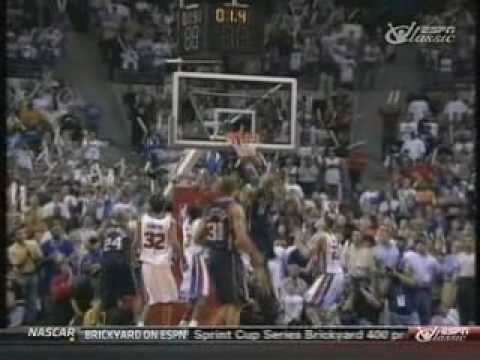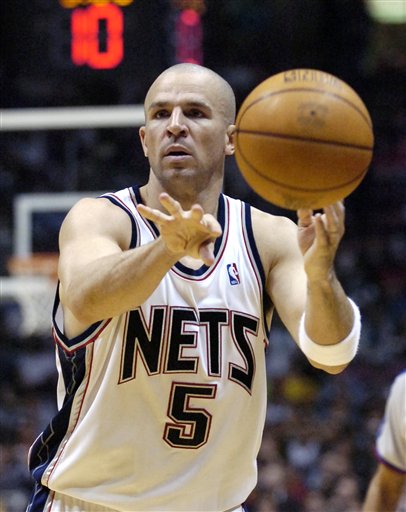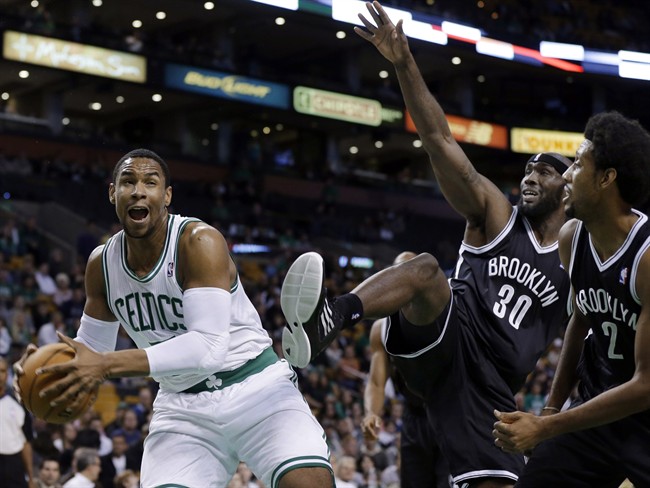It’s May 18, 2003. The Nets are fresh off a sweep of the Boston Celtics, four wins away from their second consecutive Finals appearance. The Pistons are in the Eastern Conference Finals for the first time since 1991, and they smell blood. With 22 seconds remaining, Chauncey Billups ties the game at 74 on two free throws, leading Byron Scott to call a time-out.

The movement begins with under 10 seconds left, and it’s soon obvious that this is a clearout play. Martin sets a screen for Kittles to draw him to the left side, and Martin simply rolls over post-screen to the opposite block. This gives Kidd all the space on the right side he could ever want. However, with the Nets playing so close to each other in the 1-4 wing set, the Pistons effectively rotate to cut off all passing lanes – even for Jason Kidd! – which leaves a poor jump shooter stranded on an island in the right corner, forced to shoot a highly difficult shot over Chauncey Billups and the 7-foot Mehmet Okur.
He rattles it in. 76-74. After a timeout, Okur misses an awkward layup attempt on the other side. The buzzer sounds. The rest is history.
What made the play so beautiful is, quite frankly, how bad it was. Hey, let’s throw one of the best team players and worst shooters of his generation into a late-game isolation, forcing a guy having a 5-18 night against one of the best defensive teams in the NBA into shooting over a double team with barely any time left! Foolproof! It sounds maniacal, and it is; yet Kidd was able to get around Billups in that corner and create just enough “quick space” to get a clean look over Okur. You can see that in the picture to your right; Billups is standing down next to Kidd with no way to contest the shot, and Kidd’s fade and quickness meant that Okur couldn’t get out quick enough for a clean contest.
There was doubtlessly a little luck involved, and only a few players are that great to allow themselves that luck. Let no revisionist history change the truth: in his prime, Jason Kidd was one of those players.
Kidd preserved the victory, the winning streak, and quite honestly the series. The Nets collapsed in the third quarter, as they turned the ball over seven times and were outscored 27-12, while the Pistons were sparked by a textbook quarter from Chauncey Billups (the only quarter in this game where his contributions meant something). Their victory was a frantic fourth-quarter comeback that they nearly blew – clawing back into the game, they went from down eight to begin the fourth to up seven with four minutes left, only to watch that lead evaporate as no Net but Kidd made a field goal after Kenyon Martin’s dunk with 5:45 left.
An unanswerable question looms over that night: without that shot, do the Nets win in overtime? Remember, this Detroit team was 8-0 in overtime games this season, and Detroit’s crowd was in full force these days. I can’t see them winning on the road when given an extra five minutes against a deep, overtime-killing team. And without that blueprint, the confidence from game 1, do they win game 2 on the road? Again, I have my doubts. Game 2 was another nailbiter that relied on the Nets executing just enough down the stretch. That Pistons core of Billups, Rip, Tayshaun Prince, and the Wallaces led the Pistons to the NBA Championship the next year, something Kidd’s Nets never did.
Yet instead of arguably facing a 2-0 deficit, the Nets cakewalked to the NBA Finals, entering on a ten-game winning streak after sweeping their last two foes. The sheer combination of smarts and luck that came from that one fallaway shot arguably extended the Kidd dynasty one more year.
It’s important to remember that those teams weren’t only Jason Kidd. Kenyon Martin may have come from the most disappointing NBA Draft of all time, but he was at this point an excellent defender, tenacious rebounder, and a big who could finish in traffic with flair. Richard Jefferson was proving that the deal Rod Thorn made to acquire him on draft day was an absolute steal. Jason Collins kept doing those weird things that made Jason Collins helpful – bodying up anybody 1-on-1 on defense, and opening the floor by setting tough screens both on and off the ball on offense.
But it’s also completely fair to remind everyone that the Nets were 26-56 the year before acquiring Jason Kidd, and 52-30 the following year. It’s not called the “Kidd/Collins/Jefferson/Martin/Lucious Harris/Aaron Williams/A couple years of Vince Carter” era. It’s the “Kidd” era.
You may remember Jason Kidd by the good things like this. You may remember him for the bad things, like his messy off-the-court issues, coach clashes, and trade requests. All I know for sure is that nobody who’s ever suited up for New Jersey did more for this franchise, nobody gave the Nets legitimacy, nobody single-handedly extended a few careers in New Jersey like Jason Kidd did. And that one shot, that one ridiculous, crazy, no-logical-reason shot was the final stamp needed on his case as the greatest point guard the Nets had ever seen.
Thanks, J-Kidd.

















